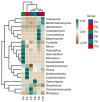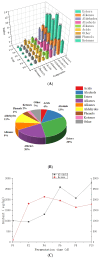Study on the Fermented Grain Characteristics and Volatile Flavor Substances during the Tuqu Fermentation of Hunan Light-Flavor Baijiu
- PMID: 38540889
- PMCID: PMC10969214
- DOI: 10.3390/foods13060899
Study on the Fermented Grain Characteristics and Volatile Flavor Substances during the Tuqu Fermentation of Hunan Light-Flavor Baijiu
Abstract
The present study employed Hunan local Tuqu for fermentation and investigated the physicochemical properties, microbial community composition, and volatile flavor compounds of the fermented grains, as well as the correlation between the physicochemical indicators and the microbial community. The findings reveal that the activities of α-amylase and glucoamylase were highest during the initial stages of the fermentation process. The acid protease activity increased to 30.6 U/g on the second day and then decreased. Cellulose and lipase activities both showed an increasing trend. The moisture content increased sharply to 73.41% and then remained relatively stable. The acidity was highest on the eighth day. Fifty genera of bacteria and twenty-two genera of fungi were detected. Lactobacillus was dominant among bacteria, and Saccharomyces was dominant among fungi. A correlation analysis showed that there were positive correlations between moisture, acidity, cellulose, lipase activities and Lactobacillus, and there were positive correlations between moisture content, acidity, cellulase activity, acidic protease activity and Saccharomyces. A total of 46 volatile flavor compounds were detected, of which 6 alcohols and 14 esters constituted the major portion, and 9 key flavor compounds with an ROAV > 1 were identified throughout the fermentation process. Isoamyl acetate had the highest ROAV and made the greatest contribution to the flavor.
Keywords: bacteria; fermented grains; fungi; light-flavor Baijiu; volatile flavor substances.
Conflict of interest statement
Author Huitai Chen was employed by Hunan Guoyuan Liquor Co., Ltd. Huitai Chen has contributed toward project administration. The objectivity and authenticity of the experimental results and discussion were not affected by the company. The remaining authors declare that the research was conducted in the absence of any commercial or financial relationships that could be construed as a potential conflict of interest.
Figures












References
-
- Li R.-R., Xu M., Zheng J., Liu Y.-J., Sun C.-H., Wang H., Guo X.-W., Xiao D.-G., Wu X.-L., Chen Y.-F. Application Potential of Baijiu Non-Saccharomyces Yeast in Winemaking through Sequential Fermentation with Saccharomyces cerevisiae. Front. Microbiol. 2022;13:902597. doi: 10.3389/fmicb.2022.902597. - DOI - PMC - PubMed
-
- Tang J., Liu Y., Lin B., Zhu H., Jiang W., Yang Q., Chen S. Effects of Ultra-Long Fermentation Time on the Microbial Community and Flavor Components of Light-Flavor Xiaoqu Baijiu Based on Fermentation Tanks. World J. Microbiol. Biotechnol. 2022;38:3. doi: 10.1007/s11274-021-03183-3. - DOI - PMC - PubMed
-
- Wang L., Wang Y.Y., Wang D.Q., Xu J., Yang F., Liu G., Zhang D.Y., Feng Q., Xiao L., Xue W.B., et al. Dynamic Changes in the Bacterial Community in Moutai Liquor Fermentation Process Characterized by Deep Sequencing: Dynamic Changes in the Bacterial Community in Moutai Liquor. J. Inst. Brew. 2015;121:603–608. doi: 10.1002/jib.259. - DOI
LinkOut - more resources
Full Text Sources

